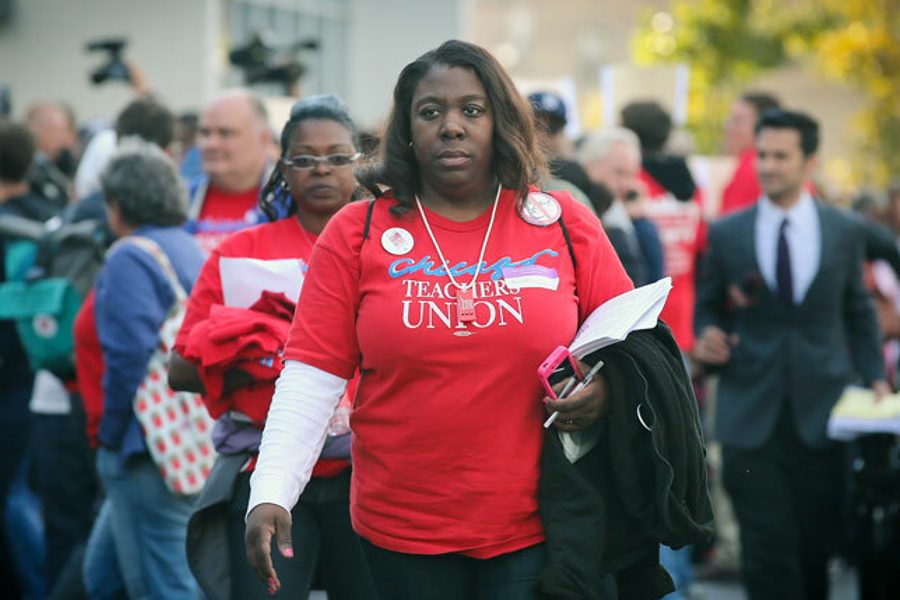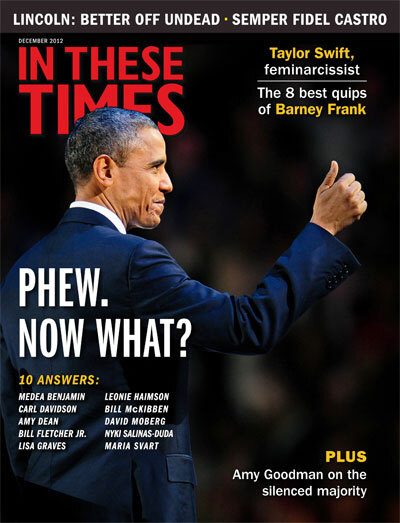Democratic to the CORE
The Chicago Teachers Union’s secret to success? The rank and file are in control.
Micah Uetricht and Jasson Perez

During September’s Chicago Teachers Union (CTU) strike, local and national media rushed to frame the fight as a clash of oversized personalities: the stubborn, foul-mouthed Mayor Rahm Emanuel against the brash chemistry-teacher-turned-union president Karen Lewis. Even progressive media hyped Lewis as the driver of the union’s victory, praising her personal toughness as more than a match for Emanuel. It was classic “Great Man” historicism, tracing the strike’s origins to leaders’ personal traits.
Few accounts mentioned the constituencies behind these leaders. For Emanuel, this includes anti-union charter-school advocates, who donated $12 million toward his election. In Lewis’ case, it was the dictates of her 30,000 members. Indeed, the CTU is one of the most vibrantly democratic union locals in the United States.
Since a 2010 upheaval within the CTU, rank-and-file teachers have made up the union’s leadership, and members make many of its day-to-day decisions. Public actions are typically planned and executed by members themselves, not paid staff. And the CTU took the incredible step of extending its September strike an extra two days to ensure members had a chance to examine and debate the proposed contract.
As Lewis puts it, “We put the power into the hands of the rank and file, where it belongs.”
In recent decades, as the American labor movement has declined in membership and power, several unions have undergone a sea change, with new leaders proposing bold visions for how to revitalize labor. But rarely have those visions been as closely tied to a commitment to member-led democracy as in the CTU.
Shifts in leadership
Unlike many unions, in which officials cling to power for decades, the CTU has a long history of leadership turnover. Even when leaders did not run the union democratically, the CTU’s structure allowed for reform caucuses to develop. The United Progressive Caucus (UPC), which was rooted in racial justice caucuses in the 1970s but failed to push back against corporate education reform, held power for three decades. Proactive Chicago Teachers (PACT), a reform caucus pledging to recapture a past union militancy, briefly unseated the UPC in 2001 — the same year current Secretary of Education Arne Duncan became CEO of Chicago Public Schools (CPS), pushing an agenda of closing public schools and opening charters.
Leadership changed hands three times in nine years — an incredible frequency compared to most American unions. Then, in 2010, teachers elected the Caucus of Rank and File Educators (CORE), a reform caucus with deep roots in community-level education equality fights. CORE had learned from PACT’s failures. Upon her election as CTU president, Lewis stated that CORE would “change this into a democratic union responsive to its members.” CORE immediately began restructuring the union. Leadership broadened the rights and responsibilities of members in the governing House of Delegates. Fourteen member-led committees, from political action to media, were tasked with central roles in the union’s day-to-day functioning. A new training program prepared delegates and members for union organizing and governance. At schools, committees of teachers, parents and students were organized to facilitate activism independent of union leadership. Quickly, educators began to take control of their union. “We turned our members into organizers, then we cut them loose,” says CTU staffer Matt Luskin.
Charlotte Johnson has been a teacher’s assistant for 19 years in CPS. For most of that time she was uninvolved in the union. “I can’t even remember what the president’s name was,” she says, referring to the UPC era. “You’d hear things were happening, but they weren’t good.”
Johnson says CORE leadership engaged members right away through programs like a summer organizing initiative, where activists knocked on other members’ doors and discussed workplace issues face to face in their homes. “That’s the only way you can hear from 26,000 people,” she says.
That commitment to bottom-up engagement was on full display during the 2012 strike. Members spontaneously planned and executed actions such as protests against Democratic aldermen hostile to the strike, often without even a nudge from staff.
Kim Walls, a science teacher at Robert Fulton Elementary, had never been active before CORE members approached her in 2010. She attended the union’s summer organizing program, where she first heard about tax increment financing (TIFs), a city policy that diverts resources away from public institutions such as schools to corporations.
On September 14, the union and the Grassroots Collaborative coalition planned a rally against TIFs downtown, focusing on billionaire hotel heiress and CPS board member Penny Pritzker. Her company, Hyatt Hotels, had received $5.2 million in TIF funds to build a new hotel in Hyde Park, where Walls lives.
Walls recalls Luskin telephoning her days prior about the action. “I said, ‘Matthew, I’m not going downtown. There’s a Hyatt right here.’ ” She told Luskin she would organize her own protest against Hyatt in Hyde Park. “He just said, ‘Go for it.’ ”
So Walls called Hyde Park-area teachers and told them to “call their people” to come out to the action. When the day came, 300 teachers and supporters marched on the hotel — with little to no support needed from union staff.
Two extra days
After the strike’s first week, many Chicagoans assumed teachers would return to class Monday. Emanuel had lost the public relations battle: Polls showed strong majorities, especially among CPS parents and Chicagoans of color, backing teachers. The union had the upper hand in bargaining, and the draft agreement CTU leaders brought to the House of Delegates meeting that Sunday, which CPS had signed off on, was rumored to be strong.
Which is why many in the local media were stunned when delegates voted to stay on strike for at least two more days — not because the proposed agreement was unfavorable, but because members wanted more time to examine it. Instead of forcing membership to decide on a contract that they had not read and did not fully understand, delegates extended the strike to ensure members “wouldn’t feel like anything was being shoved down our throats,” as delegate and first-grade teacher Yolanda Thompson put it.
Favorable coverage in the mainstream press evaporated. Nevertheless, on Monday morning, teachers arrived at picket lines outside their schools at 6:30 a.m., eager to review the proposal but lacking a formal process. Becca Barnes, a ninth-grade history teacher on the South Side, says teachers at her school made photocopies of the contract, stood against a fence, and spent an hour reading through line by line, circling key sections and commenting in the margins — as though they were grading papers. As they began picketing, the contract was still on their minds. So Barnes and her fellow teachers — about 100 of them — decided, right there on the picket line, to walk to a nearby park and read it together.
“None of us planned in advance to comb through it collectively,” Barnes says.
But that’s what they did, at first only for the big picture.
“We were going to just go over highlights,” Barnes remembers, “but then someone said, ‘No — we need to read the entire contract!’ ”
So, sitting together at a park, they read through every line, passionately debating the victories and concessions hashed out at the bargaining table.
“It was very emotional,” says Barnes. “Some people were sick of striking. Others said, ‘This isn’t good enough. This one line is reason enough for me to stay out.’ ”
Similar scenes took place throughout Chicago. For the first time, teachers were studying every word of their contract, the principal document governing their work lives, sometimes emotionally and contentiously, but together.
“We were genuinely interested in what each other had to say — even the people who wanted to go back,” Barnes says. The union voted to ratify the contract October 3, with 79 percent of membership in favor.
One CTU staffer, Norrine Gutekanst, says she was “a bit concerned” when delegates extended the strike, thinking “public opinion would turn against us.” “It was inconvenient,” she says, “[but] because this leadership is committed to bottom-up democracy, we just felt like we had to do this, and that it would result in a much stronger union.”
Mark Brenner, director of Labor Notes, an organization dedicated to fostering union democracy, says this commitment sets the CTU apart from much of American labor. “There’s a lot of cynicism in labor about the capacity of ordinary, working-class people to run their unions,” Brenner says. “Leaders think those people should have good lives, but they don’t think they have the capacity to do big things.” That cynicism, Brenner says, has prevented other unions from engaging members the way Chicago teachers have. “Even among ‘progressive’ unions, democracy is not high on the list of must-haves. That has really hurt our movement,” he says. “Democracy is what builds the capacity to take high-stakes, risky actions like the CTU did.”
CTU-style democracy ‘dangerous’
The labor movement is still parsing the lessons of the CTU strike. Illinois’ AFSCME Council 31 appears emboldened by the CTU, publicly praising the strike and stirring rumors of a potential work stoppage in their battle with Democratic Gov. Pat Quinn.
Other union leadership has been made skittish by the CTU example. Referring to a CORE-style caucus fighting a recently negotiated Newark Teachers Union contract introducing merit pay, NTU President Joe Del Grosso seemed nervous. “They had some signs there that we should follow Chicago’s lead,” Del Grosso recently told Working In These Times’ Josh Eidelson. “I think that’s very dangerous.”
In New York City, the Movement of Rank-and-File Educators (MORE), a dissident caucus challenging the current leadership of the United Federation of Teachers (UFT), draws inspiration from the CTU’s rank-and-file democracy.
Kit Wainer, a social studies high school teacher and member of MORE, says that under the UFT’s current leadership, “There’s no real process for members to have any kind of direct say in the day-to-day direction of the union. There’s formal democracy, but no substantive democracy.”
The problem, Wainer says, is not that the UFT lacks a broad social-justice vision — it’s that rank-and-file teachers are not engaged in democratic practices within the union to enact that vision. “[UFT President Mike] Mulgrew talks about poverty, about charters as a privatization scheme by the rich,” Wainer says. “The problem is they won’t mobilize members to fight. Their idea of fighting is hiring lobbyists and lawyers to go to Albany, or buying TV commercials.”
If MORE’s slate can capture leadership like CORE, Wainer says, “We’d build up membership confidence and willingness to struggle. We could reteach members what the union is.”
When’s the meeting?
Proponents of the CTU’s bottom-up organizing style say there is no other way to win. “Top-down just does not work. It’s the style of the bosses,” says Kenzo Shibata, a CORE member who taught English for 10 years before heading social media for the union.
Brenner agrees: “The strike would never have been successful if they hadn’t spent a year and a half trying to identify leaders in the schools and give them the training to be real leaders in the union.”
Kim Walls sees her union activism, begun in earnest only three years ago, as a starting point. She and her colleagues have been emboldened through their organizing and are considering finding a teacher to run for city council. She says she texted a CTU staffer about their plans.
“He responded, ‘Great. Let me know when the meeting is.’ ”
Micah Uetricht is a labor organizer in Chicago and a contributing editor at In These Times who has written for Salon, the American Prospect and Jacobin. He is at work on a book on the Chicago Teachers Union.
Jasson Perez is a native Chicagoan who has worked as a community and union organizer for 11 years. He is a field organizer for SEIU Local 73, a member of Stone Soup Cooperative, and a member of the hip hop group BBU.





